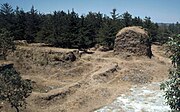Portal:Mesoamerica/Selected article/17

Qʼumarkaj, (Kʼicheʼ: [qʼumarˈkah]) is an archaeological site in the southwest of the El Quiché department of Guatemala. Qʼumarkaj is also known as Utatlán, the Nahuatl translation of the city's name. The name comes from Kʼicheʼ Qʼumarkah "Place of old reeds".
Qʼumarkaj was one of the most powerful Maya cities when the Spanish arrived in the region in the early 16th century. It was the capital of the K'iche' Maya in the Late Postclassic Period. Archaeologically and ethnohistorically, Qʼumarkaj is the best known of the Late Postclassic highland Maya capitals. The earliest reference to the site in Spanish occurs in Hernán Cortés' letters from Mexico. Although the site has been investigated, little reconstruction work has taken place. The surviving architecture, which includes a Mesoamerican ballcourt, temples and palaces, has been badly damaged by the looting of stone to build the nearby town of Santa Cruz del Quiché.
The major structures of Qʼumarkaj were laid out around a plaza. They included the temple of Tohil, a jaguar god who was patron of the city, the temple of Awilix, the patron goddess of one of the noble houses, the temple of Jakawitz, a mountain deity who was also a noble patron and the temple of Qʼuqʼumatz, the Feathered Serpent, the patron of the royal house. The main ballcourt was placed between the palaces of two of the principal noble houses. Palaces, or nimja, were spread throughout the city. There was also a platform that was used for gladiatorial sacrifice.
